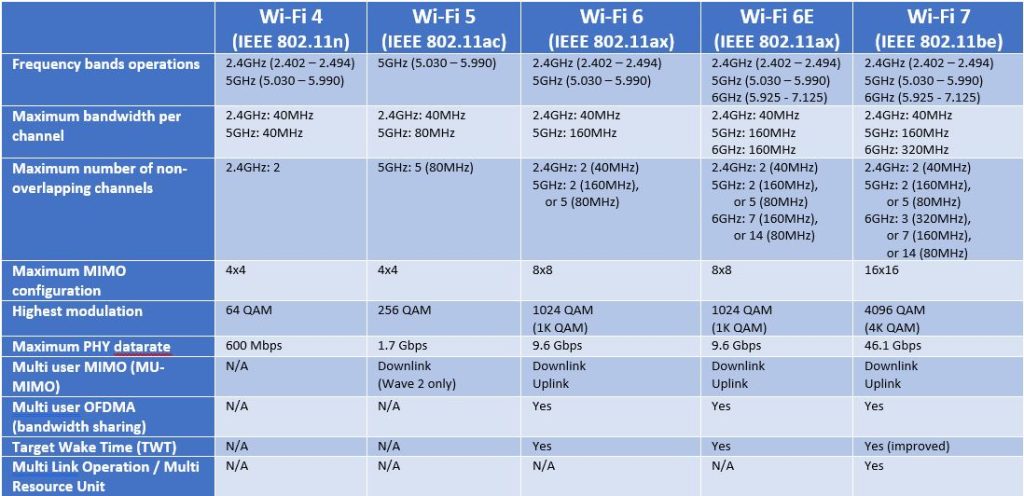Ever since the WiFi Alliance was formed in 1999, WiFi technology has continuously evolved to serve the ever-growing demand for higher throughput and higher number of devices, with an alphabet-challenging series of version names. It became so popular that it entered into the dictionary as a common name. Today it provides the ubiquitous internet connection for a wide variant of clients, from data hungry devices like laptops, smartphones, TVs and set-top boxes, to IoT ‘tweeting’ devices like home/office appliances. The annual devices shipments are increasing every year and are expected to exceed 5 Billion units in 2026 according to ABI, with future growth mostly driven by the Smart / Connected Home and Wearable market segments.
What is WiFi 7?
WiFi 6E, ratified in 2020, has just started to be rolled out on the market and we are already being teased with the next generation, WiFi 7, even though the specification is far from being complete. Indeed, the next generation of WiFi is not expected to be ratified before 2024. However, there is already a lot of buzz around it, with several semiconductor companies announcing the sampling of “pre” WiFi 7 chips. Originated from the IEEE 802.11be specifications, WiFi 7 will come with bigger muscles:
- Up to 320MHz channel bandwidth, compared to 160MHz in WiFi 6E. This is available only on the 6GHz band.
- Up to 16×16 MIMO configuration, compared to 8×8 in WiFi 6/6E.
- 4K QAM maximum modulation, compared to 1K QAM in WiFi 6/6E
Knowing the above benefits, should companies who have not yet migrated to WiFi 6E wait until WiFi 7 is available?
A bit of WiFi history
Before answering the question, let’s first compare the main characteristics of each WiFi generation. They are summarized in the below table:

What is WiFi 6?
Compared to WiFi 5, WiFi 6 comes with double the maximum MIMO configuration, double the maximum channel bandwidth and a higher modulation scheme. This translates to more than 5 times maximum data rate at PHY level. Even though that is quite significant, this is not what made WiFi 6 so popular, with the fastest penetration rate ever for a new WiFi generation.
The main benefit of WiFi 6 is higher network efficiency, particularly in dense areas where more devices can be connected to the same access points, delivering a better user experience with higher throughput and lower latency. This higher efficiency is coming from two major features, among others:
- Multi-user MIMO (MU-MIMO): this divides the MIMO operation of an Access Point (AP) between multiple users (or stations). For instance, an 8×8 AP can handle up to eight 1×1 users simultaneously, one per spatial stream. The AP sends a single 8×8 MIMO packet over the air (downlink) containing data for each user on its respective allocated spatial stream. Each user can reply (uplink) simultaneously on its respective spatial stream. MU-MIMO downlink was already supported in WiFi 5 Wave 2, while MU-MIMO uplink was not.
- Multi-user OFDMA (MU-OFDMA): this allows the total available bandwidth to be divided among several users into what is called Resource Units (RU). This way, more users can be connected to the AP. For instance, up to 37 simultaneous users can share an 80MHz channel, each using just 2MHz bandwidth. Furthermore, such narrow band allows better coexistence with other narrow band technologies such as Bluetooth and 802.15.4 (i.e., Thread, ZigBee).
MU-MIMO and MU-OFDMA enable an AP to better schedule traffic among users, with proper granularity and better control on Quality of Service. Hundreds or even thousands of devices can be connected to the AP with limited congestion. Moreover, the slower WiFi 6 IoT devices can seamlessly coexist with WiFi 6 high demanding devices without impacting their throughput and latency.
Another great feature of WiFi 6 is Target Wake Time (TWT). It is particularly interesting for low power IoT devices: each WiFi 6 device connected to the AP can go into deep sleep and wake up at its respective scheduled time pre-negotiated with the AP. It minimizes conflicts and significantly reduces the power consumption.
What is WiFi 6E?
WiFi 6 operates on the 2.4GHz and 5GHz bands. But the 2.4GHz band is crowded, with WiFi competing with other technologies such as Bluetooth, Zigbee and Thread. The 5GHz band is the express highway to avoid this congestion.
However, the demand for data bandwidth is never satisfied. There are now many more video streaming services offering higher resolution video. In many parts of the urban world, fiber-to-the-home is being rolled out, offering the potential of super-fast internet which then needs to be served out within the home/office. The recent surge in working from home during the covid 19 pandemic also increased the appetite for reliable, high-speed WiFi. The capacity of even the 5GHz express highway of WiFi 6 is being stretched. So WiFi 6E has been released to expand the capacity using the 6GHz band (more precisely, from 5.925GHz to 7.125GHz). This extra 1.2GHz bandwidth adds up to 7 channels of 160MHz each (whereas only 2 such wide channels were available on the 5GHz band), or up to 14 channels of 80MHz each (only 5 were available on the 5GHz band). Despite the geographical challenges around the 6GHz spectrum, WiFi 6E is proving to be very popular, creating some much-needed breathing room in the relentless search for data bandwidth.
WiFi 7 in more details
WiFi 7 is almost 5 times faster than WiFi 6/6E. But this is not the only reason for the sudden appetite for WiFi 7. Two very important features are driving attention to this next WiFi generation:
- Multi Link Operation (MLO): this provides the ability to aggregate two channels from the same or different bands in order to increase the throughput, stepping around interference and reducing latency. For example, it may be very challenging or even impossible to get a free 320MHz channel on the 6GHz bands, among the 3 such channels available, because of interferers. To overcome this situation, thanks to MLO, a WiFi 7 connection can aggregate two disjointed 160Mz channels in the 6GHz band, from the 7 channels available, or one channel on the 6GHz band with another one on the 5GHz band. Any combination is theoretically possible, including for instance aggregation of 160MHz + 80MHz channels on the 5/6GHz bands.

MLO can also be used for load balancing, by quickly and seamlessly switching between channels to minimize contentions/retries. This also translates into a reduction of the latency.
- Multi Resource Unit (MRU): When there is a need for “large” resource unit driven by user’s throughput requirement, such a large bandwidth may not be free throughout the whole channel bandwidth. So, with a similar concept to MLO, but on the same channel, two contiguous or disjointed Resource Units may be aggregated for a single user to achieve the throughput requirement.
Thanks to MLO and MRU, WiFi 7 is very attractive, particularly in applications with high throughput, low latency and high link reliability requirements. How, when and which channels to aggregate is where the Wi-Fi 7 solutions providers will differentiate. Wi-Fi 7 will bring great value in dense environments such as airports and offices, where users move and have dynamic WiFi requirements, regularly switching between emailing, browsing, chat, file transfer and video conferencing. Gaming, AR/VR headset and video distribution will also benefit a lot from WiFi 7. So if these use cases are relevant for you, you will certainly want to move to WiFi 7 as soon as it is available.
CEVA is the leading provider of WiFi platform IP solutions for integration into SoCs, powering hundreds of millions of Wi-Fi-enabled devices. The CEVA Waves WiFi solutions include a selection of market proven MAC and modems for various generations of the WiFi standard (WiFi 4/5/6/6E), supporting station/client (STA) and access point (AP) modes in SISO and MIMO configurations for bandwidths up to 160MHz. The CEVA RivieraWaves WiFi IP platforms are well complemented by the CEVA Waves Bluetooth platform IPs and/or the CEVA Waves UWB platform IPs to form wireless combo solutions.


